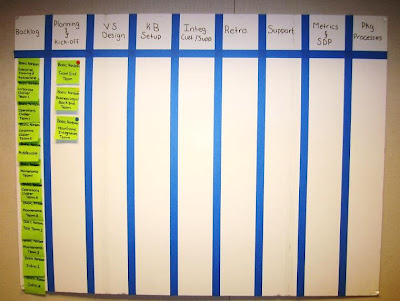We have been running large transformation projects for the last several years helping organizations to become more agile in their delivery.
A typical approach one often encounters is to select a pilot project, run the pilot and then move onto another pilot.
Based on our experience, we recognize two major issues with the project pilot oriented approach:
1- People already are participating on multiple projects. This causes multitasking that is not captured by the Kanban system. This makes the pilot very limited in terms of value.
2- Organizations often select a project that is just starting. These projects can take as much as 3-6 months to get out of the conception phase. This makes seeing any real momentum impossible.
As a result, we are trying a different approach, one that takes an organization/ team perspective. We hope to eliminate some of the challenges inherent in a project based approach.
We start with a group of early adopters that are working on inflight projects and visualize all of their work.

We are adopting based on “delivery nodes”. We view the organization as a network of interacting units that provide business value. We select a subset of the organization that uses a single technology solution. We get the team onboard with Kanban and try to stabilize their work.
As we are getting an understanding of other work surrounding this delivery node, we can decide who to adopt next. The adjacent node is determined by looking at both risk and value. We want to promote flow for all work under the current scope of adoption while simultaneously expanding our scope.
This approach will allow adoption to proceed using a continuous approach, maximizing flow throughout the organization connecting customers, suppliers, and peers in each subsequent wave.

Implementing basic Kanban throughout the organization allows further insight into the tools/ skills/ methodologies that can be adopted to improve the teams’ capabilities. Additional capabilities, such as feature decomposition and test driven development can be developed as incremental change units and rolled out through the organization where applicable.
We created a roll out plan to have large adoption waves on-boarding 50-60 FTE's per month. After month 2, the basic Kanban implementation is reduced to half to allow the organization to adapt to the new work systems and to start implementing the incremental units of change.
A Kanban board is created to model the rollout plan. The backlog represents the teams that will be trained on the basic Kanban and the incremental units of change.

The adoption wave is a 9 week effort program. Each of the adoption waves will start with a week of Planning & Kick-off and then followed by an 8 week training and coaching program. During the 8 week period there are 6 major learning, workshop and support activities that are essential for a successful implementation.

A Kanban board is developed to model the training material to track the progress of each of the teams through the training program.

We kicked-off training sessions with multiple teams. In a later blog post we will review our initial approach and share our experience on onboarding the teams to their first Kanban board.







